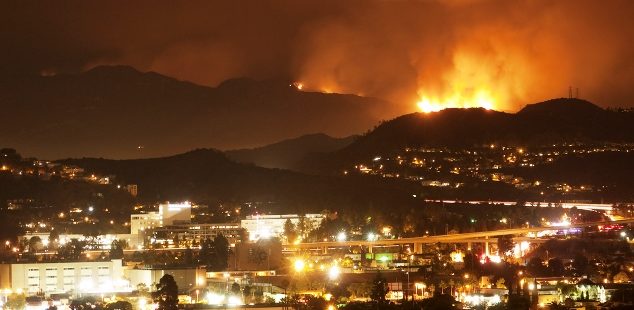Opinion
Fighting climate-related disasters
 A major fire near Los Angeles. (Photo: Brian C. Weed, via Shutterstock)
A major fire near Los Angeles. (Photo: Brian C. Weed, via Shutterstock)You don’t have to be a scientist to know that the climate hasn’t been California’s best friend the last few years.
Floods, mudslides, multi-year drought and massive, destructive wildland fires are only some of the extreme climate-related disasters California and its local communities face. If you live in California, the odds are that you are living in a danger zone.
The proceeds generated by carbon dioxide emission allowances auctioned under California’s “cap and trade” program provide a unique opportunity to invest in our state.
To mitigate such disasters, California leans heavily upon our local fire departments, which make up the backbone of our state’s disaster response network. Local agency firefighters respond to one in three wildland fires in California. Nearly 40 percent of all Californians live in a county where all of their fire response – urban and wildland – is provided by local government.
Our firefighters are the first line of defense when a climate-related emergency strikes. We applaud Governor Brown and Legislature for taking steps in recent budget cycles to aid the state’s disaster response by making certain state-level investments. However, much more work needs to be done.
The relentless stream of disasters threatens to break the back of our critically stressed local resources. In fact, last year mutual aid requests from the state went unfilled by local governments in more than 5,500 instances – in whole or in part – because the local resources simply weren’t there, continuing a disturbing trend that has grown dramatically in the past few years.
Delayed or insufficient response to a climate-related disaster not only puts lives and property at risk for those in the immediate area – it also creates an economic impact that is felt across the state. The 2015 Valley and Butte Fires hit Amador and Lake Counties with nearly $1 billion in property loss and over $1.1 billion in lost business. The 2016 Sobrantes Fire cost Monterey County more than $1 billion in lost tourist business. That same year, Riverside County’s Blue Cut Fire cut access to a critical shipping route, which cost shippers over $1 million a day.
And, just this past Fourth of July holiday weekend, California’s fire agencies and first responders battled more than a half dozen major incidents. Our state’s disaster response network is on track to be stretched once again to the breaking point in 2017.
California must act to help our disaster response network not only absorb changes that have already occurred due to our shifting global environment, but also to ensure that our state and its communities are adequately prepared for predicted future response pressures and needs.
Fortunately, a solution is currently on the table.
Every year, the proceeds generated by carbon dioxide emission allowances auctioned under California’s “cap and trade” program provide a unique opportunity to invest in our state, specifically in the areas that are most affected by the environmental changes brought about by such emissions.
Currently, there exists a proposal before lawmakers that would commit a portion of California’s cap-and-trade proceeds toward disaster response, thus creating a dedicated and ongoing source of funding for the state and local agencies that so desperately need it.
This is the time for lawmakers to act and the disaster response proposal before them provides a clear path forward. The need to prepare for, and respond to, this wide scope of climate-related emergencies isn’t going to ebb and flow – it’s just going to get worse.
It is essential that we commit the needed resources now: for the sake of our citizens, our state and local fire agencies, our first responders and California’s overall economic health.
—
Ed’s Note: Lou Paulson is the president of the California Professional Firefighters. Michael DuRee is president of the California Fire Chiefs Association.
Want to see more stories like this? Sign up for The Roundup, the free daily newsletter about California politics from the editors of Capitol Weekly. Stay up to date on the news you need to know.
Sign up below, then look for a confirmation email in your inbox.

California can start by undoing ICL Specialty Chemicals sole source contract for all wildland fire chemicals. The main ICL chemical, retardant, is toxic, expensive and does not extinguish fires – in fact, it was never designed to extinguish fires.
You only need to look at the Fire Aviation blog to see that Global Supertankers took its 19,600 gallon capacity 747 air tanker to Chile in late January/early February 2017. The 747 picked up Pyrocool, an environmentally preferable chemical, in Houston on the way to Chile. No special mixing base was needed. The tanks were filled with water and 70 gallons of Pyrocool was injected from the Pyrocool totes in the lower hold into the tanks in the main hold.
The 747/Pyrocool-water mix was dropped directly on the wildland fires. The 747/Pyrocool-water mix was credited with extinguishing the fires as it was dropped and saving many resource. It was also credited with saving the town of Llico, Chile which was being overrun with a wildland fire.